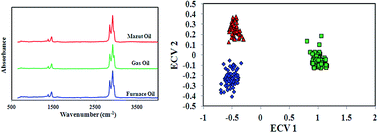Application of ATR-FTIR spectroscopy and chemometrics for the discrimination of furnace oil, gas oil and mazut oil†
Abstract
Fuel oil is one of the petroleum fractions and it can be classified into different grades according to its composition and properties. Discrimination of the types of fuel oil is important in quality control, environmental monitoring and industry. In this work, some chemometric methods were examined for the classification of 264 fuel oil samples from three types of oil (furnace oil, gas oil and mazut oil) with the aid of attenuated total reflectance Fourier transform infrared (ATR-FTIR) spectroscopy. For this purpose, principal component analysis (PCA), extended canonical variates analysis (ECVA) and interval extended canonical variates analysis (iECVA) were used. PCA was not able to discriminate fuel oils but ECVA showed a good ability for classification purposes. On the other hand, iECVA was effective in indicating the fingerprint sub-regions in the FTIR spectra and decreasing the model’s complexity. The proposed models were validated by different statistical methods and excellent specificity and selectivity were obtained. ATR-FTIR spectroscopy coupled with chemometrics helps to present a fast, powerful and reliable approach for the discrimination of the grade of fuel oils which is important in quality control and environmental monitoring.


 Please wait while we load your content...
Please wait while we load your content...